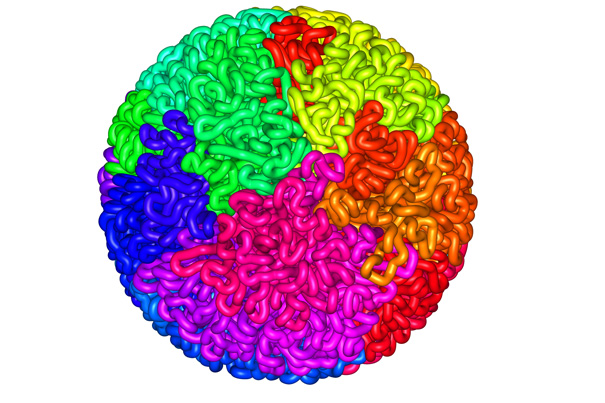A new 3D view of DNA
March 13, 2012

DNA packs itself tightly into a structure known as a “fractal globule.” The structure is unique in that the genome is completely unknotted. “Despite how densely it’s packed, you can pull on it, easily get to the region you want to transcribe, read it off, and put it back when you’re done,” explained Erez Lieberman Aiden. (Credit: Miriam Huntley, Rob Scharein, and Erez Lieberman-Aiden)
A new imaging technique is giving scientists their first three-dimensional view of the human genome,
The finding, by Erez Lieberman Aiden, a Junior Fellow of the Society of Fellows, working with Nynke van Berkum, Louise Williams, and a team of researchers from the Broad Institute of Harvard and MIT and the University of Massachusetts Medical School, suggests that how DNA is packed into cells may be at least as important as the biological coding it contains.
Producing those 3-D images required an innovative new imaging technique dubbed Hi-C that relies on the genome’s constantly shifting nature.
“Traditional nuclear magnetic resonance imaging techniques are able to determine how far atoms are from each other, and extrapolate the structure of the molecule from that information,” Aiden said. “What we’re doing is quite different. You can think about the genome as a noodle that’s in a rapidly boiling pot. Every once in a while two parts of the noodle collide.
“What Hi-C does is measure the rate at which collisions happen between any two pieces of the genome. As you might expect, points that are nearer to each other are more likely to collide with one another, but sometimes points that are far apart collide more than we would expect.”
By pairing data about how often those collisions happen, and how quickly the collision rate drops at different points along the genome, Aiden and his colleagues are able to produce 3-D models that illustrate how DNA is packed inside cells.
Aiden’s hope is that the technique might eventually help unlock the physical processes that take place when genes are switched on or off, and how cells that contain identical genetic information become the many types of cells that make up the human body.
Early results suggest that, when packed into cells, DNA forms a structure called a fractal globule. Though capable of holding vast amounts of material, the structure is unique in that the material is completely unknotted, meaning, Aiden said, that “despite how densely it’s packed, you can pull on it, easily get to the region you want to transcribe, read it off, and put it back when you’re done.”
The data has also revealed that active and inactive portions of the genome are spatially segregated, indicating that the very way the genome is folded may play a role in which genes are active.
“It’s unclear right now whether a gene gets turned on and then is immediately relocated, or if the relocation itself is enough to turn a gene on,” Aiden said. “But in some sense what we were able to observe is a sort of epigenetics via origami.”
Ref.: Erez Lieberman Aiden, Zoom!, Science, 2011; [DOI:10.1126/science.1216288]